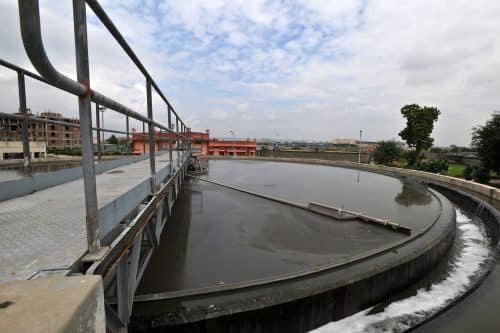Water desalination, which led to a revolution in water supply in Israel, involves a relatively high cost and environmental damage. That is why it is just as important to develop alternative water sources - this is exactly what some young researchers at the Technion are doing

By Assaf Ben Naria, Angle - Science and Environment News Agency
The rain that has plagued us in recent times, and the impressive achievements in the desalination of sea water in Israel, do not change the fact that the demand for drinking water and water for agriculture, gardening and industry will only increase in the years to come. In order to provide the necessary fresh water for the population of Israel, a dramatic increase in the amount of desalinated water will be required, from 600 million cubic meters per year today to approximately 1,500 million cubic meters in 2050.The master plan for the water sector of the water authority.
Since desalinated water is relatively expensive compared to other sources, attempts are being made to find alternative sources of desalination. Two studies conducted at the Technion present such alternatives: one, expanding the reuse of water by utilizing gray water; The other, utilization of the rainwater in the urban areas. Both studies were presented at the "Water Research in Israel - The Future Generation for Research and Industry" conference that was recently held at the Technion in Haifa.
Decentralized treatment system
Municipal sewage is a significant and available source of water, and appropriate treatment allows it to be used for irrigation and industry. It is worth noting that in some countries, of which Israel is not one, treated wastewater is even fed into the water system for domestic consumption.
How It Works? The method used today is to collect wastewater from residents' homes, public institutions and industrial areas and transport it to a central treatment facility (TTP). Such a system has many advantages in the field of control and control over the efficiency of the process.
Despite the advantages of these central systems, a professional discussion of a new approach has arisen in recent years: a distributed care system. In such a system, the gray water (collected from showers and wash basins) is separated from the general waste stream. The gray water undergoes a simple local treatment, after which it is used to flush toilets and irrigate gardens. The rest of the wastewater is discharged to the MTS.
Distributed gray water treatment, carried out at the building or neighborhood level, has significant economic and environmental benefits, including a reduction in energy consumption and operating costs and a strengthening of community involvement in the process. This is similar to installing solar panels on private roofs or growing food on green roofs.
In Tamar Ofer's research, the centralized approach used today was compared against three alternatives that include urban reuse. In the study, conducted under the guidance of Prof. Eran Friedler and Prof. Aviad Shapira from the Faculty of Civil and Environmental Engineering at the Technion, the following alternatives were examined: separating the gray water from the wastewater and recycling it at the level of the individual building; Separating and recycling them at the level of the building (a block of eight buildings), and transferring some of the treated wastewater from the MTS back to the city. A full life cycle sustainability analysis was conducted for all the alternatives, which included reference to three areas: cost, impact on the environment and social benefit.
The gray water cycle alternative at Ramat Hambanan received the best score among the three. This alternative is characterized by energy savings, which results mainly from the reduction in the amount of desalinated water (desalination is a relatively expensive process in terms of energy) and from the reduction of the drinking water discharged into the city and the wastewater discharged into the MTS. The distributed use of gray water not only saves resources but also reduces greenhouse gas emissions, the pollution of natural water sources and the emission of many pollutants related to the life cycle of municipal wastewater.
The distributed treatment systems already exist today and there is no technological obstacle to integrating them into the Israeli water system. The treatment units examined in this study were of the RBC type, which is based on biological treatment using microorganisms fixed on a rotating substrate immersed in the treated water. At the end of the treatment, the water is disinfected. The home treatment facility can be placed in the yard of the building or on the roof, but in any case separate piping is required to transport the water to and from the facility.
It is worth noting that the most significant challenge in gray water recycling is not technical but legal and bureaucratic, since today the field is not legally regulated.
Phosphorus, aluminum and titanium in the runoff water

Another way to increase the amount of water available in Israel is to collect runoff water - water that originates from the roofs of buildings, sidewalks, roads and other places in built-up areas. Today, most of this water flows into the municipal drainage system, meaning it is not used. Researchers from the Technion and the Hebrew University, funded by KKL-Junk, decided to check how the situation could be changed and to that end they checked the quantity and quality of runoff water in a typical city in Israel: Kfar Saba. The researchers examined three different drainage areas in the east of the city - an area of houses, an area of small industry and a section of road near the Teva factory.
Adi Haft, a graduate student at the Technion, presented the summary of the research results: the industrial area produces, relative to its size, twice as much runoff water as the residential areas. The reason for this: the high percentage of the built-up area out of the total area. However, when the researchers checked the quality of the water, they discovered that it contains high concentrations of phosphorus, aluminum and titanium - substances that are dangerous to human health. Relatively high values of pollutants such as heavy metals and phosphorus were also measured in water originating from homes.
The researchers discovered that in the runoff water in eastern Kfar Saba (and apparently in other cities in Israel) the concentration of pollutants is twice that of what is common in cities around the world, and Haft explains this by the considerable time difference between one rain event and another. "In Israel," Haft says, "every rain becomes the first rain, while in other countries rain is a routine matter." How does that happen? "After a long period of dryness, various polluting substances accumulate on the roads and built surfaces, which are washed in high concentrations into the drainage system with the arrival of the first significant rain."
From Haft's research it appears that the runoff water of Kfar Saba does not meet the established standards and therefore it should not be discharged into the sea or streams without treating it first. Treatment of this water will allow its utilization for uses such as irrigation. Such a challenge is not particularly complicated for the scientific community in Israel, which as mentioned already knows how to turn seawater into drinking water.

2 תגובות
It has a simple formula:
Every time the Kinneret level goes down, the subject rises, and every time the Kinneret level rises, the subject goes down.
Major projects that had been planned and made headlines in drought years were put on hold for political reasons when the rains returned.
After they invented reverse osmosis, it was finally quite easy to desalinate water, but they waited until Israel dried up to death and then in the XNUMXs they wanted to invest in desalination plants in the wrong amount with the wrong efficiency, they established wasteful water corporations...
In Israel there is almost no utilization of energy from the wind, there is no utilization of energy from the sun due to political reasons and pressure from monopolies.
We have a sea full of water, we have a sky full of sun most of the year, there are winds, there are currents, there are alternative energy sources and there are Israeli patents that are not being used.
With proper long-term planning, and the correct order of priorities, they could have long ago turned the country into a country that does not depend on rainfall.
There are not enough wastewater treatment facilities, the wastewater treatment facilities in Israel in the places where they exist do not function with sufficient efficiency.
There is no collection and storage of drainage water and floods in the winter.
Even today, there is no reason for the water prices. Today, a cubic meter of desalinated water at the exit from the desalination plant costs NIS 3.
The citizens are charged twice for water, once an exorbitant price of four times the cost and once as a sewage fee.
I wish…